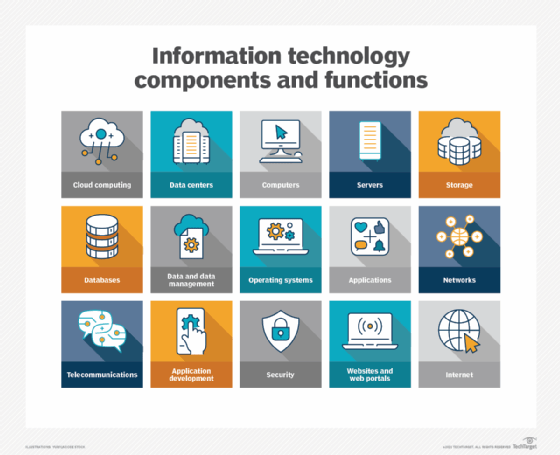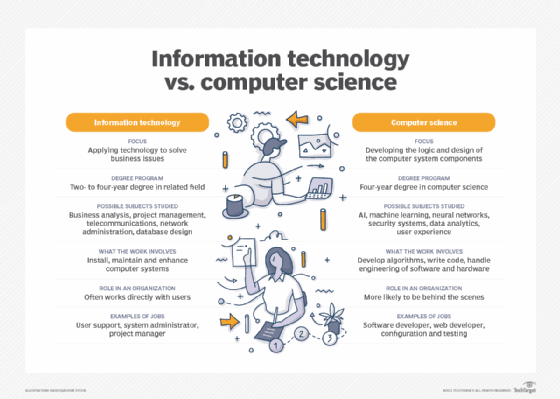A Task That a Worker Can Either Perform or Not Perform Is Called Essential Knowledge.
What is it?
Information technology (It) is the use of any computers, storage, networking and other physical devices, infrastructure and processes to create, process, store, secure and exchange all forms of electronic data. Typically, IT is used in the context of business operations, equally opposed to technology used for personal or amusement purposes. The commercial use of Information technology encompasses both computer technology and telecommunications.
The Harvard Business Review coined the term it to make a distinction between purpose-built machines designed to perform a limited scope of functions, and general-purpose computing machines that could exist programmed for various tasks. Every bit the It industry evolved from the mid-20th century, computing capability increased, while device cost and energy consumption decreased, a cycle that continues today when new technologies emerge.
What does it cover?
The Information technology department ensures that the system'south systems, networks, data and applications all connect and function properly. The IT team handles three major areas:
- deploys and maintains business applications, services and infrastructure (servers, networks, storage);
- monitors, optimizes and troubleshoots the performance of applications, services and infrastructure; and
- oversees the security and governance of applications, services and infrastructure.
Most Information technology staff take dissimilar responsibilities inside the squad that break into several key areas including:
- Administration. Administrators handle the twenty-four hours-to-twenty-four hours deployment, operation and monitoring of an IT environs, including systems, networks and applications. Admins often perform a range of other duties such as software upgrades, user training, software license direction, procurement, security, data management and observing adherence to business process and compliance requirements.
- Support. Assistance desk staff specialize in answering questions, gathering information and directing troubleshooting efforts for hardware and software. IT back up oftentimes includes IT nugget and change direction, helping admins with procurement, handling backup and recovery of data and applications, monitoring and analyzing logs and other functioning monitoring tools and following established support workflows and processes.
- Applications. Businesses rely on software to perform work. Some applications are procured and deployed from third parties, such as email server applications. But many organizations retain a staff of skilled developers that create the applications and interfaces -- such as APIs -- needed to evangelize disquisitional business capabilities and services. Applications might exist coded in a wide array of popular languages and integrated with other applications to create smooth and seamless interactions between different applications. Developers might besides be tasked with creating interactive business websites and edifice mobile applications. The trend toward agile or continuous evolution paradigms require developers to be increasingly involved with IT operations, such as deploying and monitoring applications.
- Compliance. Businesses are obligated to discover varied government- and industry-driven regulatory requirements. IT staff play a major role in securing and monitoring admission to business information and applications to ensure that such resources are used according to established concern governance policy that meets regulatory requirements. Such staff are deeply involved with security tasks and routinely interact with legal and business teams to prevent, discover, investigate and written report possible breaches.

Why is information technology important?
It's been said that data is what powers industries worldwide. That may be hyperbole, but few businesses -- big or small-scale -- can remain competitive without the ability to collect data and turn it into useful information. It provides the means to develop, process, analyze, exchange, shop and secure information.
Data processing plays a significant role in these cadre concern practices, among others, including:
- production development and design;
- marketing and market research;
- sales and invoicing;
- customer development and retentiveness;
- accounting and taxes;
- human resources and payroll; and
- regulatory compliance.
Computing has penetrated practically every office of business and much of our personal lives. The ubiquity of computing -- also referred to as pervasive computing -- is another reason why It is critical. Computing devices have evolved well beyond personal computers and servers. Today, all businesses and most individuals have and use multiple calculating devices, including phones, tablets, laptops, game consoles and even doorbells, thermostats, vacuums and many kitchen appliances.
Virtually all these devices, many of which are part of the IoT, tap into the internet, which interconnects billions of devices worldwide. It'southward a complex and, potentially, perilous surroundings that requires Information technology expertise for management, security, maintenance and reliability.
Examples of information technology
So how is Information technology actually involved in 24-hour interval-to-day business concern? Consider five common examples of IT and teams at work:
- Server upgrade. One or more data centre servers near the end of their operational and maintenance lifecycle. Information technology staff will select and procure replacement servers, configure and deploy the new servers, backup applications and information on existing servers, transfer that information and applications to the new servers, validate that the new servers are working properly and then repurpose or decommission and dispose of the old servers.
- Security monitoring. Businesses routinely apply tools to monitor and log activity in applications, networks and organization IT staff receive alerts of potential threats or noncompliant behavior -- such as a user attempting to access a restricted file -- cheque logs and other reporting tools to investigate and determine the root cause of the alert and take prompt action to accost and remediate the threat, often driving changes and improvements to security posture that can prevent like events in the time to come.
- New software. The business determines a need for a new mobile application that tin allow customers to log in and access account information or conduct other transactions from smartphones and tablets. Developers work to create and refine a suitable application according to a planned roadmap. Operations staff posts each iteration of the new mobile awarding for download and deploy the back-end components of the app to the system's infrastructure.
- Business improvement. A concern requires more availability from a critical application to help with acquirement or concern continuance strategies. The Information technology staff might be called upon to builder a high-availability cluster to provide greater performance and resilience for the application to ensure that the application tin can go along to part in the face of unmarried outages. This can be paired with enhancements to data storage protection and recovery.
- User support. Developers are building a major upgrade for a vital business concern awarding. Developers and admins volition interact to create new documentation for the upgrade. IT staff might deploy the upgrade for limited beta testing -- allowing a select grouping of users to try the new version -- while likewise developing and delivering comprehensive training that prepares all users for the new version'due south eventual release.
Software vs. hardware
IT includes several layers of physical equipment (hardware), virtualization, management systems, automation tools, operating systems, other system software and applications used to perform essential functions. User devices, peripherals and software can be included in the It domain. IT can also refer to the architectures, methodologies and regulations governing the use and storage of information.
Software
There are two categories of software: system software and applications. Organization software encompasses the computer programs that manage the basic computing functions. They include the following:
- OSes;
- BIOSes;
- kick programs;
- assemblers; and
- device drivers.
Business organization applications include:
- databases, such as SQL Server;
- transactional systems, such every bit existent-time order entry;
- e-mail servers, similar Microsoft Exchange
- web servers, like Apache and Microsoft'due south Internet Information Services (IIS);
- customer relationship management, such as Oracle NetSuite and HubSpot; and
- enterprise resource planning systems, such as SAP S/4HANA.
These applications make use of programmed instructions to manipulate, consolidate, disperse and otherwise piece of work with information for a business purpose.
Mobile applications that run on smartphones, tablets and other portable devices typically connect with cloud or information center applications over the internet. These applications take expanded the telescopic of calculating and created a new category of software and telecommunications that requires special expertise to maintain.
Hardware
In that location are many different types of computer hardware. Computer servers run business organization applications. Servers collaborate with customer devices in the client-server model. They likewise communicate with other servers across computer networks, which typically link to the internet.
Storage is some other type of hardware. It's whatsoever applied science that holds information as data. Storage may be local on a specific server or shared among many servers, and it may be installed on bounds or accessed via a cloud service. Information that is stored tin take many forms, including file, multimedia, telephony, and web and sensors information. Storage hardware includes volatile random-access memory (RAM) as well as non-volatile tape, difficult deejay drives and solid-state drives.
Telecom equipment, comprising network interface cards (NICs), cabling, wireless communications and switching devices, connect the hardware elements together and to external networks.
Abstracting hardware and software
Information technology architectures accept evolved to include virtualization and deject computing, where concrete resource are abstracted and pooled in dissimilar configurations to come across application requirements. Clouds may be distributed across locations and shared with other IT users, or they can be contained within a corporate data center, or some combination of both deployments.
Volatility is a characteristic of virtualized resource, enabling them to expand and contract equally needed. Subscription-based cloud or locally installed resources, such as storage or composable architectures, can spin upwardly resources, such as servers, OSes and application software, equally needed and then release them when processing is complete.
Information technology vs. computer science
When researching careers in IT, yous're likely to come across the term computer science. While in that location is overlap between IT and computer science, the ii are singled-out disciplines with different courses of written report to fix for careers in either area.
It
IT is more often than not associated with the application of technology to deal with business issues. As such, the IT workforce is oriented toward adult technologies such equally hardware systems, OSes and application software. Proficiency in IT is required to identify the hardware and software components that should be used to enhance a specific business organization process. IT pros work with a diverseness of technologies, such as server OSes, communications devices and software, and applications.
Training for an It career requires basic courses in hardware and software systems. It degree programs may include subjects such as:
- business organisation analysis
- project management
- telecommunication
- network administration
- database design
- database management

Information science
Information science focuses on the logic and pattern of the underpinnings of the components that Information technology experts use to assemble concern systems. A strong mathematics groundwork is required to pursue a informatics career. Much of the work in computer science involves developing the algorithms and logic and writing the low-level lawmaking that enables computer systems to address business concern bug.
Computer scientists may participate in the hardware and software engineering work required to develop products. They are too likely to delve into more than abstruse technologies, such as bogus intelligence (AI) and car learning (ML).
A course of study in figurer scientific discipline requires a foundation in computer concepts and advanced mathematics. Information technology may be complemented with subjects such every bit:
- AI and ML
- neural networks
- security systems
- data analytics
- user feel
Careers in information engineering science
A team of administrators and other technical staffers deploy and manage a company's Information technology infrastructure and avails. Information technology teams depend on a range of specialized information and technology skills and knowledge to back up equipment, applications and activities. Tertiary-party contractors and IT vendor back up personnel broaden the It squad.
The information technology profession is extremely diverse. It workers tin can specialize in fields such as software development; awarding direction; hardware components; server, storage or network administration; network compages; and more. Many businesses seek IT professionals with mixed or overlapping skill sets.
At that place is a wide array of It careers, each with varying technological and managerial requisites. Among the most common It task titles are the following:
- Chief information officer (CIO). This person is responsible for It and calculator systems that support the goals of the business organization.
- Chief engineering science officer (CTO). This person sets the engineering goals and policies inside an organization.
- IT director . This person is responsible for the function of the business'south technology tools and processes. This part may also be chosen IT manager or Information technology leader.
- System administrator (sys admin). This person configures, manages, supports and troubleshoots a multiuser computing environment. Within a business organization, this role can exist divided up by technology, requiring an administrator or team defended to server, desktop, network administration, virtualization, or other components and technologies.
- Application managing director . This person's role centers on the provisioning and management of a high-value business application, such as Exchange.
- Developer or software engineer . This person or squad writes, updates and tests lawmaking for figurer programs to see internal or customer-facing business organisation objectives.
- Principal IT architect or IT builder. This person examines and changes Information technology functions to all-time back up the concern.
IT skills and certifications
A successful It career will involve developing several technical skills. For the current Information technology job market place, these x skills are amid those most in demand:
- cybersecurity
- cloud computing
- edge computing and IoT
- It automation
- software development
- big information management and information analytics
- DevOps
- AI
- ML
- mobile application development
In the pursuit of these IT disciplines, information technology is advantageous to earn certification to demonstrate proficiency in specific technologies and areas of expertise. Some of the most highly regarded certifications include the following:
- AWS Certified Solutions Architect -- Professional person
- Certified Ethical Hacker (CEH)
- Certified in Adventure and Information Systems Control (CRISC)
- Certified Information Security Director (CISM)
- Certified Data Systems Security Professional (CISSP)
- Cisco Certified Network Associate (CCNA)
- Google Certified Professional Cloud Architect (GCP)
- Microsoft function-based certifications
- Project Management Professional (PMP)
- VMware Certified Professional (VCP)
This was final updated in August 2021
Go along Reading About it (IT)
- Operational technology vs. information technology explained
- IT vs. OT security -- and how to get them to work together
- What's the role of people in Information technology/OT security?
- 5 benefits and challenges of IT/OT convergence
- Trends push Information technology and OT convergence opportunities and challenges
Dig Deeper on Information center hardware and strategy
-

How IT can use the Microsoft Assessment and Planning toolkit
-

MIS (management information systems)
-

Collaboration and collaborative software: Glossary
-
![]()
John Swainson, president of Dell Software, argues the case for rethinking datacentres
Source: https://www.techtarget.com/searchdatacenter/definition/IT




0 Response to "A Task That a Worker Can Either Perform or Not Perform Is Called Essential Knowledge."
Post a Comment